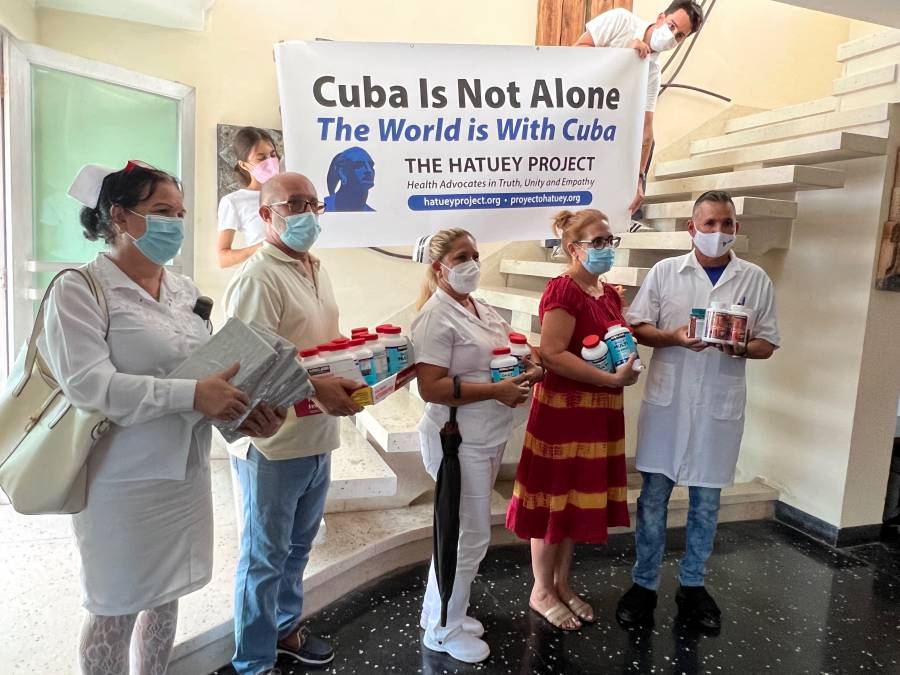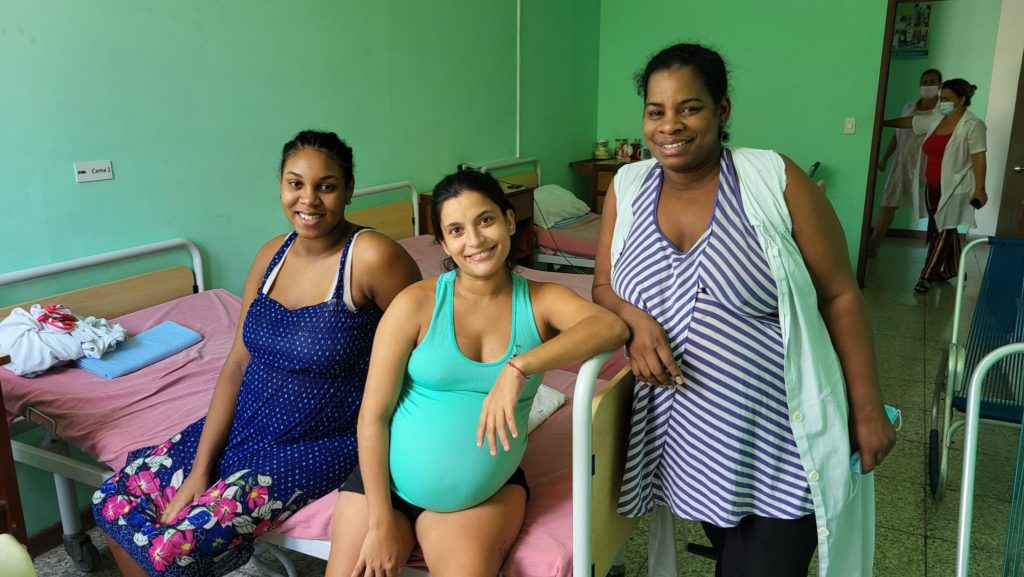I traveled to Cuba for the first time this past July, with a group of anti-blockade activists to learn about the revolution and the people. Given the severe challenges due to the U.S. economic blockade, we also brought medical supplies destined for the island’s maternity homes. I asked questions about maternity care in Cuba and shared the painful story of my first son’s birth and my frustrating and illogical 10-day separation from him in hospital. The visceral realization of what human-centered instead of profit-centered care is like, and how my experience should have been different, hit home.
Our itinerary included a visit to a maternity home in Santa Clara. But out of caution, our group was not able to tour the home because a member of our group tested positive for COVID-19. She was isolated and well cared for during that time. Instead, the doctors and nurses from a nearby clinic came to visit us where we were staying. They had the opportunity to describe their work, answer our questions and accept our donations, a small gesture of solidarity against the blockade. In spite of supply shortages, the maternal homes continue to provide a high-level of care. The unrelenting and punishing U.S. blockade chokes Cuba’s ability to replenish non-renewable and necessary supplies like those we brought with us in extra 50-pound suitcases full of prenatal vitamins, acetaminophen, yeast infection medicines, and more. We were happy to deliver the medical donations provided to us by the Hatuey Project.
I shared my story and asked what it would have been like for me to give birth in Cuba. My first son was born with a small hole in his lung and admitted into the neonatal intensive care unit for 10 days. The pinhole in my son’s lung closed over night, but he went on to suffer two apnea episodes that lengthened his stay in the NICU, in the hospital located an hour by car from our home. I was exhausted after a 23-hour labor and difficult birth. Despite the importance of fostering the mother-infant bond and such things as skin-to-skin infant-parent bonding advertised on posters in any maternity ward, this was difficult to achieve in a hospital setting where we were separated from each other. I was reduced to visitor status within two days, the standard discharge time in American hospitals. In Cuba, we would both have been cared for and kept together as long as needed, one of the doctors told me.
With the triumph of the revolution came the effort to liberate women from the social and economic repression of the past. In 1962 the first pilot-program for maternity homes was established as a comprehensive center for maternal care to support rural women’s health, and later expanded to serving any woman with a high-risk pregnancy who needed the support the centers could offer.
Pregnancy homes were established shortly after the revolution to address a problem not unique to Cuba: the need to provide necessary prenatal medical care to women with high-risk pregnancies who lived far from the nearest hospital. It was also a trend in many African and Latin American countries facing similar challenges. High-risk conditions include having had a previous caesarean section, previous fetal death, previous underweight birth, uterine rupture, multiples and more.

Zulina Bustamante Sosa, a Cuban mother of twins and Havana resident, shared her experience staying at a pregnancy home 11 years ago:
“My experience in the maternity home was difficult at first. It wasn’t easy being far from home, from my husband and family. As time passed, I understood the importance of all that care I received.
“They woke us at 7 a.m. to take our blood pressure, they monitored our diets — which were different, as were the care protocols. The doctor performed routine exams on us daily. There were educational presentations and discussions from different health professionals, including on preventative care, exercise, strategies for preventing infection during pregnancy and breastfeeding, and avoiding risky behaviors. Even how to bathe the babies! Technicians from the nearby medical clinic did blood tests on site, and they took us to the nearby clinic for ultrasounds and other tests.
“I was admitted due to the fact that it was my first pregnancy, and I was carrying twins, which is considered high risk, even though I never felt poorly during the pregnancy. The doctor discussed the test and analysis results privately with each patient, and it was up to her to release patients. Family and friends could visit daily. I was there from my 20th week of pregnancy until the 38th, and then I was transferred to the hospital where I remained for a week. Everything was planned, including the caesarean section, which was successful. In the end, I was as comfortable there as I would have been at home, and I am so happy I was able to do it because my daughters deserve it.
“The doctors and especially the nurses who cared for us night and day were wonderful, disciplined, and kind. I still keep in touch with some of them,” she said. The standard stay in Cuba after birth is five days, but Bustamante and her twins were healthy and ready to go home and discharged on day three. Most women begin their prenatal maternity leave at 34 weeks of pregnancy, and 32 weeks if carrying multiples.
Bustamante had paid leave for a year after her babies were born until they joined the infant circle. Her husband had three months of unpaid leave. The average paid leave is 17-18 weeks, including prenatal leave, although paid maternal and paternal leave is available for one year. She returned to her position at the end of that time. The new Families Code and changes to the law will allow for transfer of paid leave to whomever cares for the infant, be it a grandparent, father, aunt, or uncle. A nationwide referendum to approve the Families Code will take place on September 25.

My son remained in the NICU for eight more days. I wanted to breastfeed, and the early days of learning how to latch and establish a routine required attempts approximately every two hours. There were no overnight accommodations in the NICU, only one private room for day use with a couch available to all the families with babies in the NICU. The administrators granted me permission to use the couch at night, as long as I didn’t occupy the room during the day.
In the face of this impossible situation, my own body exhausted from labor, one of the attending NICU doctors approached me to encourage me to seek inner peace and not get stressed, for the sake of my son, warning me that otherwise my milk wouldn’t come in. Those kind words were not enough to alleviate the psychological and physical distress I experienced due to separating me from my son at that important moment, which should have been easily remedied.
At this moment in the U.S., women’s healthcare is under attack in states across the country due to the Supreme Court’s ruling in Dobbs v. Jackson, which overruled and struck down Roe v. Wade that guarateed legal abortion. Even before this moment, the maternal mortality crisis in the U.S. is well-documented: The U.S. has the highest maternal mortality rate among developed countries, with many deaths due to avoidable causes. Black women are three times more likely to die than white women. Stories of racist and xenophobic comments, lack of being listened to, and worse outcomes for people of color, and Black women in particular, are prevalent throughout the healthcare system. There is not enough postpartum support, and there are not enough maternity care providers (ObGyns and midwives). In 2018, for example, the U.S. had 11 ObGyns and four midwives available per 1,000 live births, compared to Sweden, with 12 and 66 respectively. People have trouble paying their bills and accessing care. A 1993 U.S. law established family and medical leave: 12 weeks of unpaid leave. Paid family medical leave is elusive, and job security is not guaranteed. None of these problems are faced by any Cuban parent, who in addition to accessing paid leave also has job security.
Comparing health indices between the United States and Cuba is like comparing apples to oranges. One country is arguably the most powerful and most developed in the world, and the other is a country choked by the U.S. blockade for 60 years. Yet, neonatal, infant, and child mortality rates are higher in the U.S. than in Cuba: Deaths per 1,000 live births in 2017: 3.4, 5.4, and 6.3 in the U.S., compared to 2.4, 4.1, and 5.1 in Cuba. Life expectancy is higher in Cuba. The high level of education around medical issues and basic preventative care among the population, and the fact that family doctors and nurses serve people at the neighborhood-level with an integrated care system, contribute to these positive indicators.
While in the U.S., the struggle against women’s social and economic repression continues, in Cuba, medical care is free for everyone, higher education is free for anyone who wants it, and jobs are guaranteed. The U.S. blockade is in place, supposedly, to protest violation against human rights. This is clearly a lie, as shown by this, and many other examples. The U.S. should remove the sanctions against Cuba, remove Cuba from the list of “state sponsors of terrorism,” and normalize diplomatic and trade relations. In the meantime, in the U.S., we should focus on making abortion rights a reality, improve maternal and infant care, and make healthcare free and available to all, basic human rights that Cuba provides for its people.
Photo caption: Cuban healthcare workers from the local maternity home in Villa Clara




